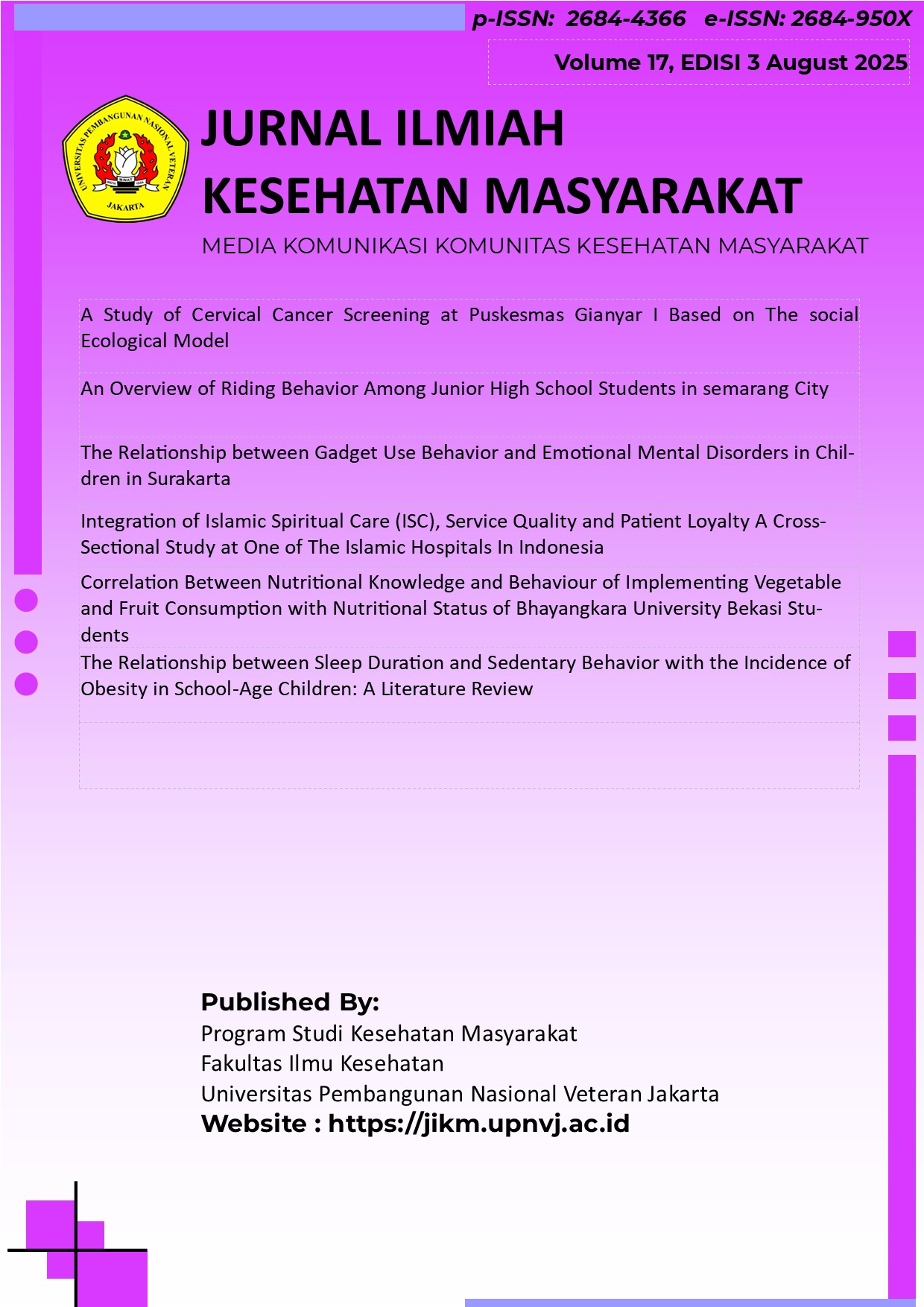The The Relationship between Sleep Duration and Sedentary Behavior with the Incidence of Obesity in School-Age Children: A Literature Review
Abstract
Background: Obesity is a growing public health issue among school-age children. Children with obesity are characterized by excessive accumulation of body fat. Various factors, for instance, lifestyle changes and sleep duration, can potentially increase the risk of obesity. This literature review aimed to identify the relationship between sleep duration, sedentary behavior, and obesity in school-age children.
Method: In this review, journal articles published in the last five years were included. All relevant articles were obtained from several databases, including NCBI, ScienceDirect, PubMed and Google Scholar. The search strategy utilized the following keywords: “obesity”, “school-age children”, “sedentary”, and “sleep duration”.
Results: A total of 255 articles were found in the initial search. These articles were subsequently screened using the PICOS framework. No more than 30 articles were eligible for inclusion.
Conclusion: The results of the analysis show that sleep duration and sedentary behavior are factors that influence the incidence of obesity in school-age children.
References
Septiana P, Irwanto I. The Relationship between Sleep Duration and the Incidence of Obesity in Children Aged 3–8 Years. Global Medical & Health Communication. 2018; 6(1):63–7.
Ogden CL, Carroll MD, Lawman HG, Fryar CD, Kruszon-Moran D, Kit BK, et al. Trends in obesity prevalence among children and adolescents in the United States, 1988-1994 through 2013-2014. JAMA - Journal of the American Medical Association. 2016; 315(21):2292–9.
Rizky Putri V, Angkasa D, Nuzrina R. Consumption of Fast Food, Soft Drinks, Physical Activity, and the Incidence of Overweight of Elementary School Students in Jakarta. Indonesian Journal of Human Nutrition. 2017; 4(1):47–57.
Silwanah AS, Amaliah A, Studi P, Masyarakat K, Tinggi S, Kesehatan I. Association of Sedentary Activity With Obesity Occurrence on Elementary School-Aged Children in Sd Thamrin Makassar. 2019; 9(2):122–7.
Jannah M, Utami TN. Factors Affecting the Occurrence of Obesity in School Children at SDN 1 Sigli, Pidie Regency. Journal of Global Health. 2018; 1(3):110.
Marcdante KJ, Kliegmen RM. Nelsons Essential of Pediatrics Seventh Edition. Elsevier; 2015.
Ortega Becerra MA, Muros JJ, Palomares Cuadros J, Martín Sánchez JA, Cepero González M. Influence of BMI on self-esteem of children aged 12–14 years. Anales de Pediatría (English Edition). 2015; 83(5):311–7.
Chi DL, Luu M, Chu F. A scoping review of epidemiologic risk factors for pediatric obesity : Implications for future childhood obesity and dental caries prevention research. 2017; (2).
Ministry of Health of the Republic of Indonesia. Limit Sedentary [Internet] Activities. 2018. Available from: http://p2ptm.kemkes.go.id/infographic-p2ptm/obesitas/batasi-kegiatan-sedentari
Sedentary Behavior Research Network (SBRN). What is Sedentary Behaviour? [Internet]. 2017. Available from: https://www.sedentarybehaviour.org/what-is-sedentary-behaviour/
Marfuah D, Hadi H, Huriyati E. Duration and quality of sleep in relation to obesity in elementary school children in Yogyakarta City and Bantul Regency. 2013
Morrissey B, Malakellis M, Whelan J, Millar L, Swinburn B, Allender S, et al. Sleep duration and risk of obesity among a sample of Victorian school children. BMC Public Health. 2016; 16(1):1–8.
Cao M, Zhu Y, Li X, Chen Y, Ma J, Jing J. Gender-dependent association between sleep duration and overweight incidence in CHINESE school children: A national follow-up study. BMC Public Health. 2018 May 11; 18(1).
Thind H, Davies SL, Lewis T, Pekmezi D, Evans R, Baskin ML. Does Short Sleep Lead to Obesity Among Children and Adolescents? Current Understanding and Implications. Vol. 9, American Journal of Lifestyle Medicine. SAGE Publications Inc.; 2015. p. 428–37.
National Sleep Foundation. https://www.sleepfoundation.org/articles/how-much-sleep-do-we-really-need. 2020. Sleep Time Recommendations.
Cao M, Zhu Y, He B, Yang W, Chen Y, Ma J, et al. Association between sleep duration and obesity is age-and gender-dependent in Chinese urban children aged 6-18 years: A cross-sectional study. BMC Public Health. 2015 Oct 7; 15(1).
Morrissey B, Taveras E, Allender S, Strugnell C. Sleep and obesity among children: A systematic review of multiple sleep dimensions. Vol. 15, Pediatric Obesity. John Wiley and Sons Ltd; 2020.
Chaput JP, Barnes JD, Tremblay MS, Fogelholm M, Hu G, Lambert E V., et al. Inequality in physical activity, sedentary behaviour, sleep duration and risk of obesity in children: a 12-country study. Obes Sci Pract. 2018 Jun 1; 4(3):229–37.
Fatima Y, Doi SAR, Mamun AA. Longitudinal impact of sleep on overweight and obesity in children and adolescents: A systematic review and bias-adjusted meta-analysis. Obesity Reviews. 2015 Feb 1; 16(2):137–49.
Chen J, Hu C, Zeng G, Xu C, Xu L, Shi J, et al. Trends and Prevalence of Overweight and Obesity among Children Aged 2-7 Years from 2011 to 2017 in Xiamen, China. Obes Facts. 2019 Sep 1; 12(4):476–88.
Nakano S, Hirano C, Hotta K, Fujita Y, Yanagi H. Factors associated with overweight status, obesity, and sedentary behavior in elementary and junior high school students. Phys Ther Res. 2019 Dec 20; 22(2):66–72.
Qiao Y, Zhang T, Liu H, Katzmarzyk PT, Chaput JP, Fogelholm M, et al. Joint association of birth weight and physical activity/sedentary behavior with obesity in children ages 9-11 years from 12 countries. Obesity. 2017 Jun 1; 25(6):1091–7.
LeBlanc AG, Katzmarzyk PT, Barreira T V., Broyles ST, Chaput JP, Church TS, et al. Correlates of total sedentary time and screen time in 9-11 year-old children around the world: The international study of childhood obesity, lifestyle and the environment. PLoS One. 2015 Jun 11; 10(6).
Wu, Y., Gong, Q., Zou, Z., Li, H., & Zhang, X. 2016. Short sleep duration and obesity among children : A systematic review and meta-analysis of prospective study. Obesity Research & Clinical Practice. https://doi.org/10.1016/j.orcp.2016.05.005
Daly CM, Foote SJ, Wadsworth DD. Physical Activity, Sedentary Behavior, Fruit and Vegetable Consumption and Access: What Influences Obesity in Rural Children? J Community Health. 2017 Oct 1; 42(5):968–73.
Tambalis KD, Panagiotakos DB, Psarra G, Sidossis LS. Insufficient sleep duration is associated with dietary habits, screen time, and obesity in children. Journal of Clinical Sleep Medicine. 2018 Oct 15; 14(10):1689–96.
Adom T, De Villiers A, Puoane T, Kengne AP. Prevalence and correlates of overweight and obesity among school children in an urban district in Ghana. BMC Obes. 2019 Apr 1; 6(1).
Chomba H, Martin HD, Kimywe J. Prevalence and Predictors of Obesity among 7-to 17-Year-Old Schoolchildren in Urban Arusha, Tanzania. J Nutr Metab. 2019;2019.
Garmy P, Clausson EK, Nyberg P, Jakobsson U. Insufficient Sleep Is Associated with Obesity and Excessive Screen Time Amongst Ten-Year-Old Children in Sweden. J Pediatr Nurs. 2018 Mar 1; 39:e1–5.
Zhang J, Jin X, Yan C, Jiang F, Shen X, Li S. Short sleep duration as a risk factor for childhood overweight/obesity: A large multicentric epidemiologic study in China. Sleep Health. 2015 Sep 1; 1(3):184–90.
Keane E, Li X, Harrington JM, Fitzgerald AP, Perry IJ, Kearney PM. Physical activity, sedentary behavior and the risk of overweight and obesity in school-aged children. Pediatr Exerc Sci. 2017 Aug 1; 29(3):408–18.
Fan J, Ding C, Gong W, Liu A, Yuan F, Zhang Y, et al. Association of sleep duration and overweight/obesity among children in China. Int J Environ Res Public Health. 2020 Mar 2; 17(6).
Vilchis-Gil J, Galván-Portillo M, Klünder-Klünder M, Cruz M, Flores-Huerta S. Food habits, physical activities and sedentary lifestyles of eutrophic and obese school children: A case-control study. BMC Public Health. 2015 Feb 4; 15(1).
Godakanda I, Abeysena C, Lokubalasooriya A. Sedentary behavior during leisure time, physical activity and dietary habits as risk factors of overweight among school children aged 14-15 years: Case control study. BMC Res Notes. 2018 Mar 20; 11(1).
Seo SH, Shim YS. Association of Sleep Duration with Obesity and Cardiometabolic Risk Factors in Children and Adolescents: A Population-Based Study. Sci Rep. 2019 Dec 1; 9(1).
Katzmarzyk PT, Barreira T V., Broyles ST, Champagne CM, Chaput JP, Fogelholm M, et al. Relationship between lifestyle behaviors and obesity in children ages 9-11: Results from a 12-country study. Obesity. 2015 Aug 1; 23(8):1696–702.
Khan MKA, Chu YL, Kirk SFL, Veugelers PJ. Are sleep duration and sleep quality associated with diet quality, physical activity, and body weight status? A population-based study of Canadian children. Canadian Journal of Public Health. 2015; 106(5):e277–82.
Lee ST, Wong JE, Shanita SN, Ismail MN, Deurenberg P, Poh BK. Daily physical activity and screen time, but not other sedentary activities, are associated with measures of obesity during childhood. Int J Environ Res Public Health. 2015 Dec 23; 12(1):146–61.
Jalali-Farahani S, Amiri P, Chin YS. Are physical activity, sedentary behaviors and sleep duration associated with body mass index-for-age and health-related quality of life among high school boys and girls? Health Qual Life Outcomes. 2016; 14(1).
Zhang J, Zhang YT, Jiang YR, Sun WQ, Zhu Q, Ip P, et al. Effect of Sleep Duration, Diet, and Physical Activity on Obesity and Overweight Elementary School Students in Shanghai. Journal of School Health. 2018 Feb 1; 88(2):112–21.
Melinda TF, Sekartini R. Association between obesity and sleep disorders in primary school children: A cross-sectional study. Medical Journal of Indonesia. 2019; 28(2):167–73.
Chaput JP, Dutil C. Lack of sleep as a contributor to obesity in adolescents: impacts on eating and activity behaviors. Int J Behav Nutr Phys Act. 2016 Sep; 13(1):103.
Tan X, Chapman CD, Cedernaes J, Benedict C. Association between long sleep duration and increased risk of obesity and type 2 diabetes : A review of possible mechanisms. Sleep Med Rev. 2018; 40:127–34.
Wheaton AG, Jones SE, Cooper AC, Croft JB. Short Sleep Duration Among Middle School and High School Students — United States , 2015. 2018; 67(3).
Kurdaningsih S, Sudargo T, Lusmilasari L, Sv K. physical activity and seedentaary lifestyle towards teenagers overweight/obesity status. 2016
Asare M, Danquah S. The relationship between phyical activity, sedentary behaviour and mental health in Ghanaian adolecents. 2015
Lampinen EK, Eloranta AM, Haapala EA, Lindi V, Väistö J, Lintu N, et al. Physical activity, sedentary behaviour, and socioeconomic status among Finnish girls and boys aged 6–8 years. Eur J Sport Sci. 2017; 17(4):462–72.
Qiao Y, Ma J, Wang Y, Li W, Katzmarzyk PT, Chaput J p, et al. Birth weight and childhood obesity : a 12-country study. 2015; 74–9.
Suiraoka IP. PREVENTION AND CONTROL OF OBESITY IN SCHOOL CHILDREN. 2015
Indrawati F. School-Based Exercise Approach in Overcoming Obesity in Children. 2015;5.
Freitag H, Muhammad L, Health DG, Medicine F, Society K. The use of school as a means of preventing obesity from an early age in adolescents. 2019; 1(2):107–14.
Ibrahim, B I. The Relationship of Physical Activity and the Incidence of Obesity in Adolescents at SMAN 1 Gamping Sleman Yogyakarta Manuscript. 2018; 33(1):37–49.









.jpg)








